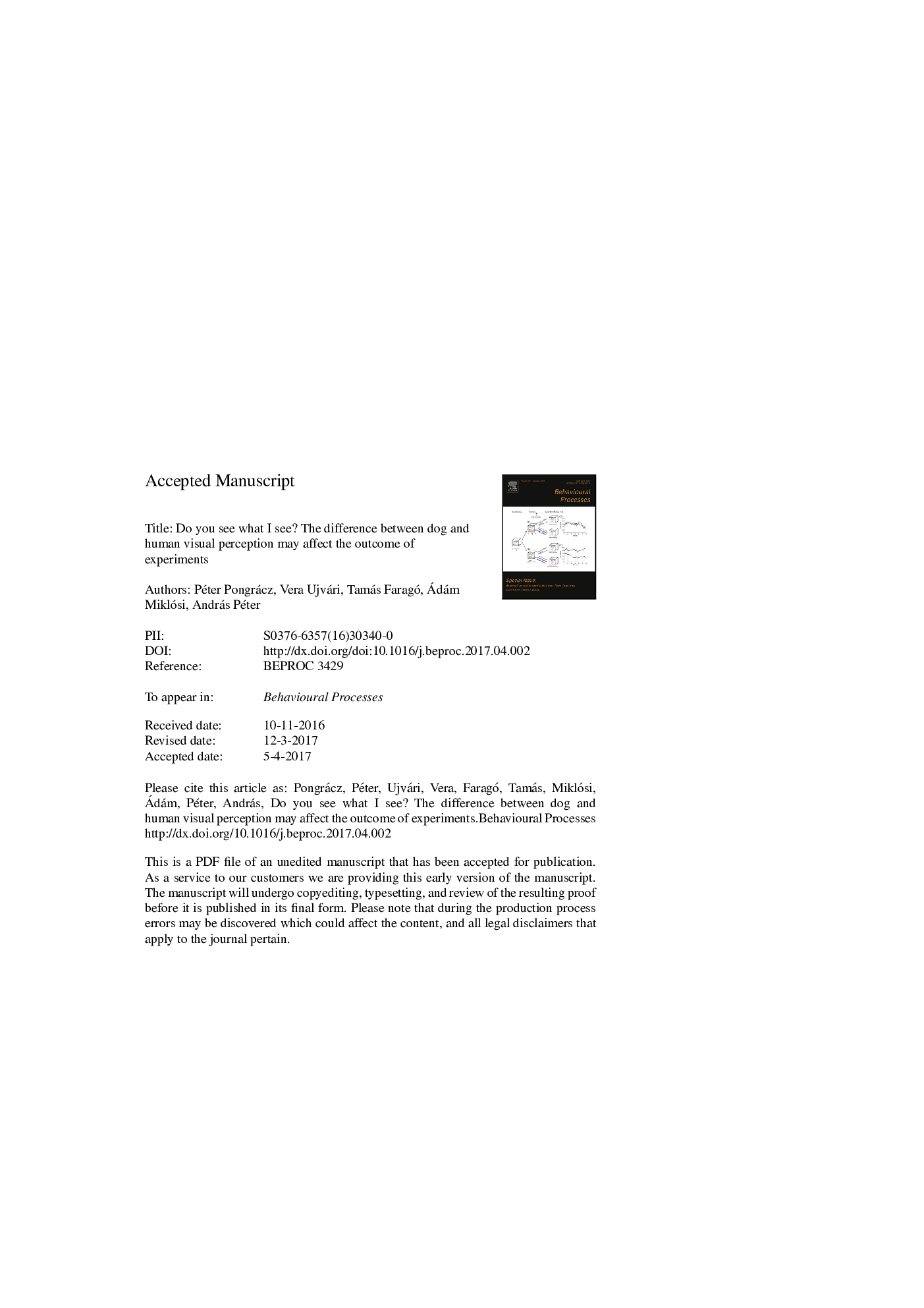| کد مقاله | کد نشریه | سال انتشار | مقاله انگلیسی | نسخه تمام متن |
|---|---|---|---|---|
| 5539771 | 1553140 | 2017 | 16 صفحه PDF | دانلود رایگان |
عنوان انگلیسی مقاله ISI
Do you see what I see? The difference between dog and human visual perception may affect the outcome of experiments
ترجمه فارسی عنوان
چیزی که من میبینم را میبینی؟ تفاوت بین ادراک بصری سگ و انسان ممکن است بر نتایج آزمایش ها تاثیر بگذارد
دانلود مقاله + سفارش ترجمه
دانلود مقاله ISI انگلیسی
رایگان برای ایرانیان
کلمات کلیدی
سگ، اخلاق، انسان، ادراک بصری،
ترجمه چکیده
حس بصری سگ ها در جنبه های مختلف متفاوت از انسان هاست. متاسفانه، نویسندگان در طراحی تجربیات خود به صراحت به تفاوت تفاوت سگ و انسان در ادراک بصری توجه نمی کنند. با توجه به اطلاعات موجود در مورد سگ بینایی، با یک برنامه دستکاری تصویر ما تصاویر ثابت را تغییر دادیم. علاوه بر تأثیر دید دایکروماتیک سگ، این نرم افزار همچنین اثرات ضعف بینایی و تبعیض روشنایی را نشان می دهد. پنجاه انسان بالغ با تصاویری آزمایش شده که نشان می دهد یک آزمایشگر زن با اشاره، چشم انداز یا نگاه به طرف چپ یا راست است. نیمی از عکسها بعد از اینکه به یک تنظیم تقریبی دیدگاه سگ تغییر یافتند نشان داده شد. شرکت کنندگان دچار مشکل شدند که هنگام تماشای تصاویر در حالت دید سگ، جایی برای دید در نظر بگیرند. با توجه به تنظیمات بینایی سگ، به مرور زمان کمتر به نظر می رسید و زمان پاسخ کمتر از سایر نشانه ها بود. نتایج ما اولین کسانی است که عملکرد بصری انسانها را در شرایطی نشان می دهد که دیدگاه ضعیف سگ را در آزمایش های اخلاقی تاثیر می گذارد. ما از محققان می خواهیم بین توانایی های ادراکی سگ ها و انسان ها، با ایجاد محرک های بصری که مناسب تر از توانایی های بصری سگ ها هستند، توجه کنند.
موضوعات مرتبط
علوم زیستی و بیوفناوری
علوم کشاورزی و بیولوژیک
علوم دامی و جانورشناسی
چکیده انگلیسی
The visual sense of dogs is in many aspects different than that of humans. Unfortunately, authors do not explicitly take into consideration dog-human differences in visual perception when designing their experiments. With an image manipulation program we altered stationary images, according to the present knowledge about dog-vision. Besides the effect of dogs' dichromatic vision, the software shows the effect of the lower visual acuity and brightness discrimination, too. Fifty adult humans were tested with pictures showing a female experimenter pointing, gazing or glancing to the left or right side. Half of the pictures were shown after they were altered to a setting that approximated dog vision. Participants had difficulty to find out the direction of glancing when the pictures were in dog-vision mode. Glances in dog-vision setting were followed less correctly and with a slower response time than other cues. Our results are the first that show the visual performance of humans under circumstances that model how dogs' weaker vision would affect their responses in an ethological experiment. We urge researchers to take into consideration the differences between perceptual abilities of dogs and humans, by developing visual stimuli that fit more appropriately to dogs' visual capabilities.
ناشر
Database: Elsevier - ScienceDirect (ساینس دایرکت)
Journal: Behavioural Processes - Volume 140, July 2017, Pages 53-60
Journal: Behavioural Processes - Volume 140, July 2017, Pages 53-60
نویسندگان
Péter Pongrácz, Vera Ujvári, Tamás Faragó, Ádám Miklósi, András Péter,
